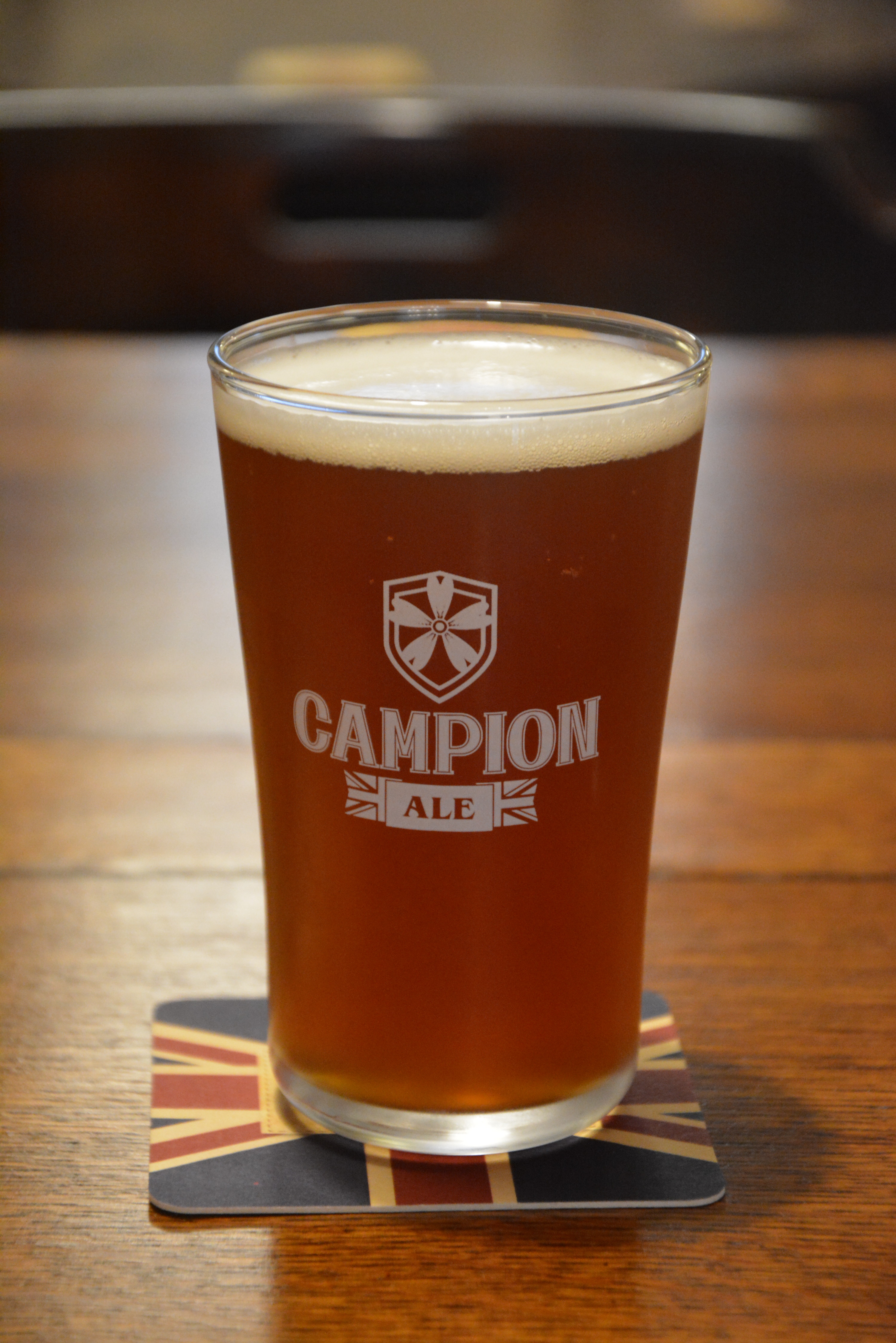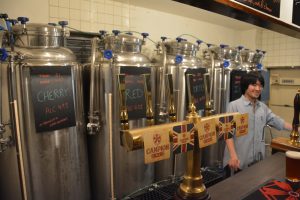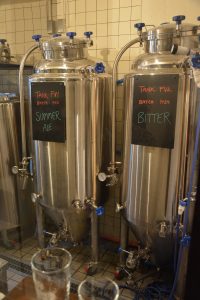Introduction To Campion Ale
Campion Ale, located three minutes from Tawaramachi on the Ginza line, one stop before Asakusa, is an example of a new breed of brewpubs opening up across Tokyo. These brewpubs make and serve their own beer on the premises, allowing thirsty drinkers to see the whole process of milling the malt through brewing and fermentation, right up to serving the beer.
Campion Ale has been open for less than a year; however, they have already produced more than 25 batches of beer, and at 250L to 300L per batch, have built up a solid customer base. This was no more evident than on one Sunday when BeerTengoku turned up to interview the owner and head brewer, James Williams, mere minutes before a torrential storm hit Tokyo. Downstairs was three-quarters full, and the second floor was half full by the time we left, around 7pm on a Sunday evening.
Campion Ale consists of two floors, with the first acting as the main brewing and serving area, and upstairs being the main drinking area. The brewing area is open for all customers to see James and his assistant, Kuroda-san, make the beer from start to finish, something akin to the soba shops of old with the soba makers by the window, rolling and cutting the soba. The second floor is furnished with authentic British-style furniture, from church pews to traditional pub stools, through to comfortable wooden chairs.
History
James Williams, the owner and head brewer, first came to Japan in 2007 under the auspices of financial consulting; however, he soon realised that his future lay in brewing rather than finances. After going to izakaya after izakaya, James became disillusioned with the regular beers served and went in search of new craft beer places, ending up in Popeye’s, near Ryogoku station, amongst others such as TY Harbor in Shinagawa, and in Asagaya.
However, much to his chagrin, these places were serving imported American craft beers, or Japanese craft beers based upon the American model: dry hopped sometimes twice or three times over, producing astringent flavours and tastes that would knock even the most hardy ale drinker back. It was then that he thought about the British styles he had known living in Surrey, UK. Thinking that there was a market for this, James returned to the UK, to the north of England, and joined a course at the BrewLab College in Sunderland.
During this course, James studied how to make traditional British style beers, ones that are full of flavour but gentle on the palate, styles such as bitters, porters, ales, and even IPAs. Moreover, the course also included recipe design, where the students were encouraged to use differing amounts of malts, hops, and barley to make their own beers. After the three-month course had finished, James felt that he had the confidence to brew his own beers and, realising that he had not finished his Japan adventures, decided to come back and open up a bar.
The license process was a long, slightly bureaucratic process but it wasn’t terrible; James thought it was reasonable. However, the main sticking point was knowing if and when he would get the license. Due to regulations, Campion Ale needed to have a location and all of the brewing equipment fully specified to even apply for the license, and then the evaluators needed to come and view the premises before issuing the license.
Once Campion Ale had obtained the happoshu license (more about that later), they were able to brew their first two batches: a bitter and a porter, one of the first milestones for them. A happoshu license differs from the classic beer license in that the brewery is not allowed to produce 100% all malt beer (although that has changed, in terms of allowing certain additives), and must produce over 6,000L a year, compared with the classic beer license that has a minimum of 60,000L a year. On top of this, the beer can be as close as possible to 100%, that is 99.9% malt, but there must be something else in the beer: for example, the cherry beer on tap.
Current set up
Right now, Campion Ale has everything on site at their Asakusa location. Campion Ale
are able to mill the malt on site (when the machine is working; it broke down at a crucial point in their early days – fortunately this has been the biggest crisis to date at Campion) right through to serving the beer. In the small area at the front of the store, customers are able to see the mash and fermentation process at work every week, with Campion Ale able to brew two beers at a time in the 350L tanks. Even though Tokyo is an expensive place to open a brewpub, it’s a novel idea in such a small place to allow everyone to see in, else why go to the lengths of opening a brewpub?
Once this process is complete, James and Kuroda-san then move the fermented beers over to the storage and serving containers behind the bar, ready for serving. While this may appear to be a large set up, the bar itself is quite small compared to other brewpubs and everything is close together. With two brews on the go every week, space is tight and James admitted that “15% to 20% more space” would be better to allow them to move around more.
As Campion Ale brews their beer all year round, the winter months are much easier for controlling the temperature needed for the yeast to ferment. In winter, it takes time to get the water up to boil; however, the summer months prove to be more problematic as the naturally higher temperatures of the environment mean that the range of temperatures in the brewing process can widely vary, pushing up the air conditioning costs and bills. Moreover, the conditioning of the beer is also harder to control.
Once the beers have been moved to the storage vessels behind the bar, the beer is ready
for serving. Due to the low carbonation levels of UK style beers, you will not see the bar staff fiddling around with CO2 dials or levers as is required by some American beers, and it also means that the beer you are served is in its ideal condition, straight out of the tank. Yet, once the beer has run out, that’s it. Luckily, while we were there, none of the beers ran out, but James did mention that this has happened once or twice during the week, particularly during busy periods, and Campion Ale sometimes only has two or three beers on tap, rather than the full range of five.
Beers are served at the more traditional temperature of just under room temperature instead of near to freezing or thereabouts. Whilst all beers are served at the same temperature, due to a single chiller system being used, the flavours in the beers come out at different temperatures, and when questioned about this, James did suggest that this is one thing that they are looking at into.
Range of beers and methods



Campion Ale’s influences are firmly rooted in British styles, hence having the bitter and the porter as the main selection, yet there are other beers being introduced that are not typically associated with British styles. The main points in brewing their beers are keeping the strength down (think less of the double or triple hopped IPAs from the US that range upwards of 8%), and keeping a malt hop balance.
Even though Campion Ale had a cherry ale on tap, this was unusual, as the brews tend to derive their fruitiness from the hops and yeast used in the brewing process rather than the addition of external flavours.
All malts and hops are produced in the UK and shipped over. The hops come in 5 kg bags direct from a supplier in the UK and get flown over. The malts are also produced in the UK and bought from a Japanese distributor. The yeast isn’t from the UK; however, it is English style that is great for imparting some of the fruity flavours of the bitters and the porters.
Campion Ale produces several different types of beers throughout the year. On the day we were there, there were five different beers on tap: a cherry ale that is made with 20kgs of Yamagata cherries; a porter; a red ale; an English style IPA, and also a wheat and rye style ale. In the fermentation area were a bitter, and a summer ale that was almost ready but not quite yet. It was disappointing but also exciting to see different beers being produced. They try to have a range of beers on tap at all times, from an amber to a porter, to ensure that there is a wide range of colours and styles on tap.
The cherry beer has been the most difficult to make so far, from sorting out the cherries to getting them ready. Half of the cherries were put into the boil, whilst the remainder were put in at a later time once the fermentation had been done, similar to the dry hopping process that double hopped beers undergo.
From their first beers, the bitter and the porter, the recipes have slightly changed since the beginning. Some of the customers noticed and commented that the beers have developed a bit; however, like most brewers, the main point is getting used to the kit and the setup. It really does have to be seen to be understood: for example, the volumes and temperatures when transferring the beers from the fermentation tanks to the storage.
In terms of other companies, James had praise for Yona-Yona ale, by Yo-ho Brewing, and also Baird Beer due to both companies being able to get their beers out into the market across Japan. Both of these companies are considered to be two of the major players in the craft beer market in Japan.
Future plans
Other companies have started to collaborate with each other, for example the Nide brand is a spin-off of Good Beer and both Baird Beer and Brimmer Brewing. However, when questioned, James was very quick to emphasize the passion of setting up the brand of Campion Ale first and foremost before going ahead and engaging in collaboration. On top of this, ideas about expansion are also a long way off as Campion Ale are still in their first year of producing beers.
The main aim is to get the bar and brewery running smoothly and ensuring that they have a solid customer base before expansion. Moreover, there are further plans to produce other special beers. In the past, Campion Ale have produced a ginger beer, made with about 1kg of freshly ground root ginger, which produced a fierce beer that divided people into either loving it or hating it. They have also produced a special festival ale, which was light and with some fruits in it. In the future, you can expect to see a brown ale, a mild and a stout at some point, and then further improvements on the IPA.
One of the most interesting plans though was for a cider, a typical British drink. In Japan, cider tends to be thought of as a lemonade style drink. But plans for this have been shelved due to the cost of apples in Japan. Aomori is the main place for producing apples; however, getting apples shipped over, fresh or in concentrated form, is an expensive process, especially when customs and shipping costs are included.
Japanese magazines have also started to take an interest in Campion Ale with magazines such as Beer Gourmet, among others, approaching them to appear in their publications. If the big four companies start producing ales and other craft beers, as Kirin announced in July 2014, this will enable them to take on some of the education of craft beers that will allow Campion Ale to fully concentrate on producing beers.
Campion Ale, whilst young, has an exciting and interesting future ahead of it, and BeerTengoku enjoyed visiting and drinking there. Check here for our review of the bar and some of the beers we tried.







2 comments
Man, James Williams is living the dream. I’ve been to Campion Ales. Friendly patrons and good beer.
Thanks for the comment.
Agreed it’s a nice place – need to get up there more often. Keep an eye out for their news in the forthcoming months. Something special coming up. 😉